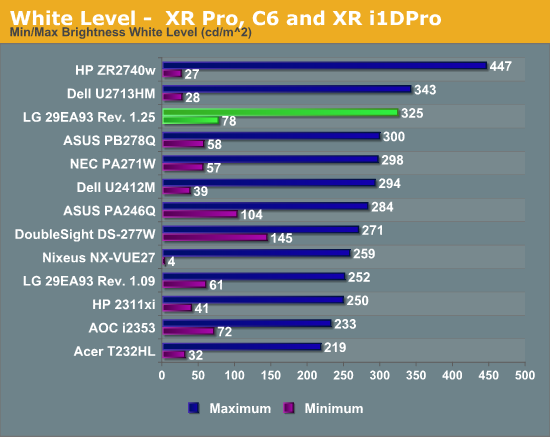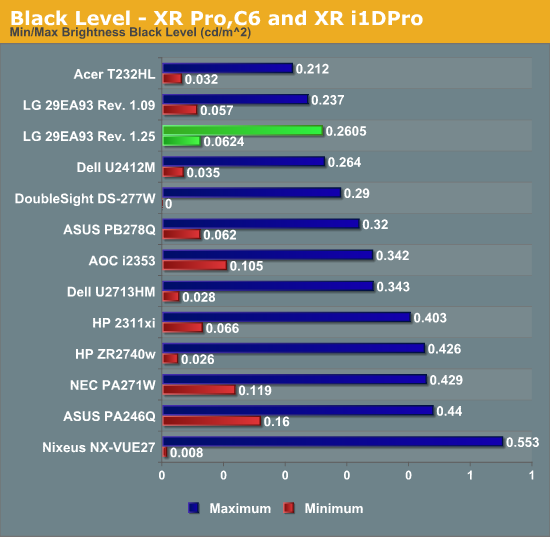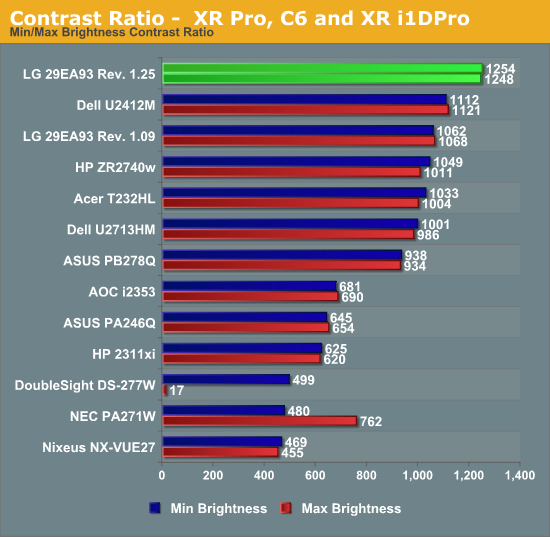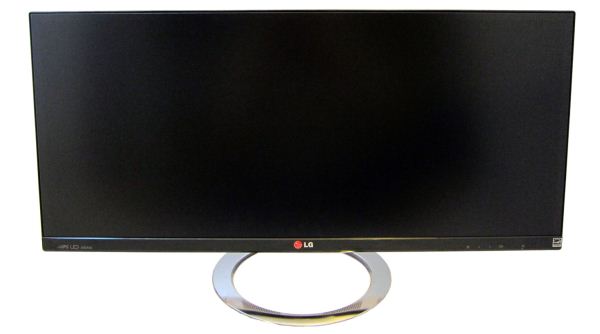LG 29EA93 Monitor Review - Rev. 1.25
by Chris Heinonen on February 12, 2013 8:49 PM ESTLast year I reviewed the LG 29EA93 monitor before its scheduled US release date. As someone that thinks there is a good market for ultrawide displays, the 21:9 aspect ratio was very interesting to me, and something I wanted to take a look at personally. While the aspect ratio was nice and enveloping for gaming, there were aspects of the monitor that were disappointing, and in the end it was something I didn't really recommend.
I really dislike writing negative reviews. Writing one means that I’ve spent a good deal of time with a product while not enjoying the experience. It means that a team of engineers and designers has spent a lot of time working on something that didn’t make the cut, or they made a series of compromises for some reason that led to an end user experience that was unsatisfying. I’d much rather write effusive praise of a wonderful product that people should run out and buy than write something bad.
Typically when I write a negative review, I either hear a little feedback from a company, or nothing at all. Maybe they knew the product wasn’t great but released it anyway, or they didn’t care. Sometimes I hear that a company will fix something, and then I try to hold onto hardware and test that to see if they do, but I’ve never had feedback like I did from LG after I initially reviewed their 29EA93 ultra-widescreen monitor.
I had multiple emails full of detailed questions about how I test, what I was after, and what should be done to improve upon the current version. After all of these conversations, they flew out an engineer with an updated version of the 29EA93 that they said would address almost all of my issues with the first version. Did LG manage to go back and correct the problems that I found, so that the monitor now performs much better? I had to go ahead and test it to find out.
Since the exterior of the 29EA93 didn’t change, I’m going to skip over that and go straight ahead to performance. You can read more about our initial thoughts on the 29EA93 in our earlier review, and we'll just pick up from there. This is the first review that uses our new CalMAN test suite for monitor reviews. Using CalMAN gives us the ability to target sRGB or AdobeRGB gamuts, choose from more gamma choices including sRGB, and have measurements that are uniform with our tablet and smartphone reviews. It also allows for better grayscale balance and error measurements, better gamut and saturation measurements, and far improved uniformity measurements.
Because of the large change, we will be making a break from everything in the past and going with DeltaE 2000 for our measurements. Because of this the numbers from this review and going forward are not comparable with older reviews as different DeltaE formulas cannot be compared. I will write a longer article on this new measurement system soon, but this will be our first use of it for a desktop display. (Anand has been using portions of these tests for tablets for a while now.)
With the initial revision of the 29EA93, the most brightness I could coax out of it was 261 cd/m². On the updated 29EA93, the highest I could coax the contrast was 78 before I started to clip blue, and just past that it began to clip every color, leading to the top shades of white becoming uniform and not distinct. Keeping the contrast at 78 allows for the highest level of light output without any negative effects at the top of the grayscale. Finding this point is actually made easy by CalMAN as well, showing you where white begins to clip in each individual color and is yet another benefit to the new software.
Using a contrast of 78 and setting the backlight to the maximum 100 results in a light output of 325 cd/m². That is much better than our previous result with the early revision. Setting the backlight to minimum, but leaving contrast steady, results in a reading of 78 cd/m². Since our new target for low-light calibration is now 80 cd/m², this is enough range for that.

The black level with the brightness at maximum is 0.2605 cd/m², and at a minimum backlight the black level is 0.0624 cd/m². Both of these are very good results given what the corresponding white levels are.

With these white and black levels, we see contrast ratios that are over 1200:1, which is a better result than before, and one of the best results that we have seen. The LG 29EA93 already produced good contrast ratios in the early revision, but with their tighter manufacturing tolerances and adjusted electronics, the 29EA93 now produces one of the best contrast ratios out there.

While the increase in light output and contrast ratios is very good to see, it wasn’t one of the main items that I was concerned about in the early unit. Even so, we're happy to see these improved results. What we really want to see are better colors and uniformity.











108 Comments
View All Comments
cheinonen - Thursday, February 14, 2013 - link
Since there seems to be a lot of feedback from those worried about the fact that LG provided a new sample that tested well, I decided to add some more comments about the matter, and clear some things up.- The first sample was also hand delivered by LG to me. Every monitor sample I have had has been from a PR company or a company directly, and none of them have been bought by myself.
- If it was so easy or even possible to hand-tune a sample to have the performance offered by Rev. 1.25 of the 29EA93, then wouldn't we expect every monitor that comes in for review to be that good? As it is, samples arrive that perform good and bad. You can look at the Acer monitor that was just reviewed to see it had issues (I had to manually loosen a screw to get the stand to work correctly, which they said would be fixed) and wasn't hand-tuned.
- You can also look at my Nixeus sample that had a brightness control issue, or many other display reviews that have been published. If it was so easy to game the system, every vendor would do it.
- Buying samples just isn't realistic. Most displays arrive for 30 days at most before going back to a company. Many arrive well before the street date so that reviews can be completed and published on the release date. This isn't possible if you need to purchase units, besides being cost prohibitive. Yes, some places would let me return them, but I have ethical issues about buying something I know I'll return, and then they will have to sell at a discount.
If I thought what LG was doing was in any way biasing my coverage, I wouldn't do it, but what they have done as far as providing samples is no different than any other company. What is different is their taking feedback and using it in a positive way, whereas many other vendors might try to deny the findings or just cut off communications, both of which have happened to me before. Being skeptical is fine, but I find no reason to think that LG wanted to anything else other than make a better product than they initially released, and providing the display to me is not different from the normal review process in any way at all.
5150Joker - Saturday, March 23, 2013 - link
Chris, LG should provide some of us a clear route to firmware upgrades that have purchased their displays. That I think is the chief concern among many of us that are concerned about buying an older version. If they were to release the updated firmware on their website in a reasonable time frame (say 1 month from now) with an easy path to upgrade, then nobody would be worried. As it is now, there is no way to differentiate between the older and newer model. This isn't limited to this model either, the LG 27EA83-D has the same problem. A korean website (www.playwares.com) was hand delivered a tuned unit and their lag tests were phenomenal. Unfortunately, I'm one of the people that already owns the 27EA83-D and would hate to be left out in the cold w/an early firmware. LG has a responsibility to clarify and rectify this situation for its customers.avihut - Thursday, February 14, 2013 - link
I was wondering which resolutions does the screen support?I mean does it only support the optimal 2560x1080 at this ratio or does it have something equivalent in the area of 1920x800 or even lower. My machine won't be able to do 2560x1080 on all my games, so I want to know if I'd be able to fall back on lower res but still get the same ratio.
Awesome review. Looks like a superb display.
cheinonen - Thursday, February 14, 2013 - link
With non-native resolutions you can have them scale to fit the screen, or do 1:1 pixel mapping for them.avihut - Friday, February 15, 2013 - link
But will the ratio preserve or will I have to play in letterbox mode?I wouldn't want to stretch 1920x1080 on this screen, since everything will look, well, stretched.
SpartanGR - Thursday, February 14, 2013 - link
How can we tell the diff between the old and the new one if i want to buy it?SpartanGR - Thursday, February 14, 2013 - link
Why can't we just firmware update our monitors? sigh....sheh - Thursday, February 14, 2013 - link
The start of the firmware-upgradable-monitor era? :) "Hey, I just overclocked my monitor using RadFirmware! Plus, scaler mode selection!"Why would TV-range chroma/luma affect contrast? It's supposed to be displayed expanded to the full range, no?
What quality differences are there in game mode?
Anyway, not the monitor for me. Waiting for some 3840x2400 24" 120Hz. OLED wouldn't hurt either, but that can wait another year or two.
cheinonen - Friday, February 15, 2013 - link
When calibrating for TV/Blu-ray/non-PC video, 16 is video black and 235 is video white, as opposed to 0 and 255 with PC content. The monitor shouldn't expand this, so you're calibrating to a smaller range. You can find some devices that will expand video content to the full RGB range (often labeled as RGB Full) that would then use the 0-255 range. For standard video content you only use a subset of that, so you'll have less dynamic range compared to PC.The PC mode was certainly bluish, with a higher color temperature, with fewer adjustments available in order to remove processing lag.
sheh - Saturday, February 16, 2013 - link
That's odd. I'd expect monitors in "TV mode" to expand 16-235/240 to 0-255, just like decent PC software players/decoders. Or maybe whatever feeds the video should do that. Or more like, either one, depending on the settings you select.Well, thanks.